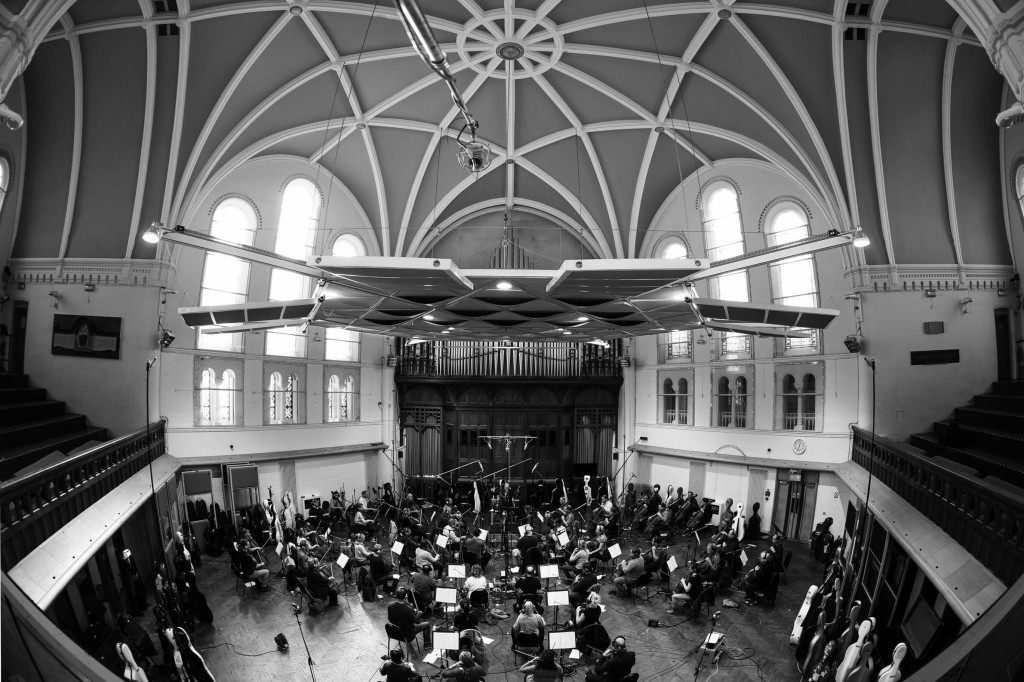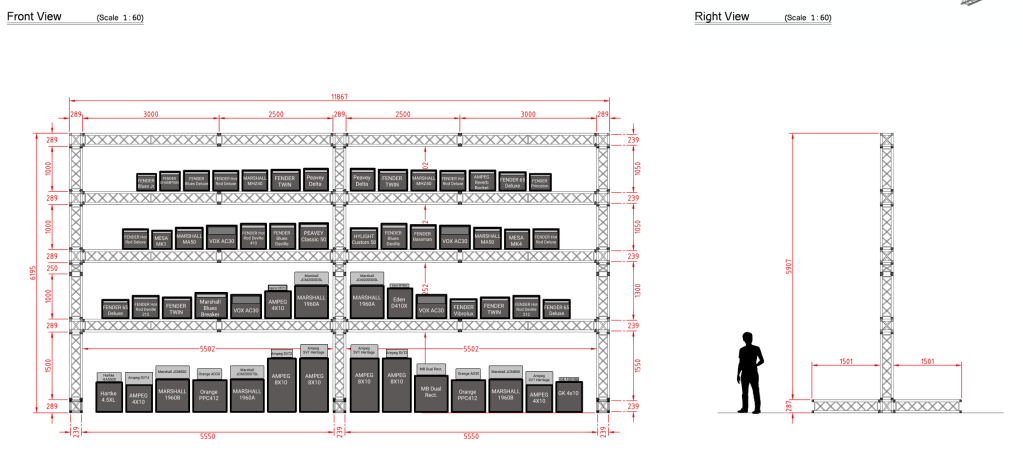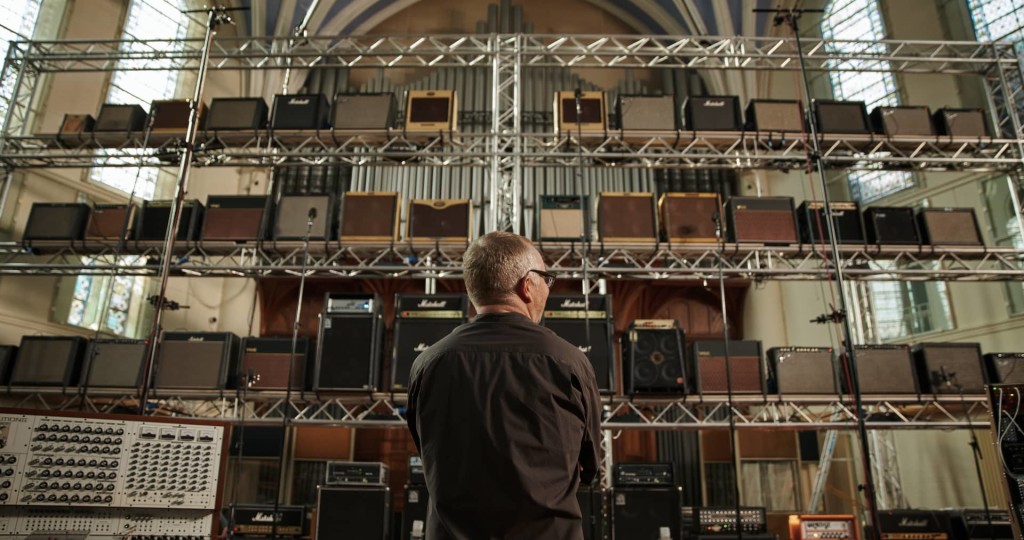Sure, you might not want more samples of drum machines, vintage synths, modular, and guitars. But Spitfire Audio are betting you might want them through 56 guitar amps, 4 subs, 4 levels of rigging, and one of the world’s largest recording rooms. Aperture is too ridiculous not to notice – and it’s free if you buy enough stuff this week (plus there’s a free demo).
It’s called Aperture: The Stack – out now.
This story starts in 1884 with the construction of the massive Lyndhurst Hall, designed by Alfred Waterhouse, the same architect who built the Natural History Museum. It’s already a massive space for, like, one amp.
Spitfire went more than a bit mad on this one. They constructed a massive rigging to support 56 guitar amps and 4 subs into a giant stack, then did what we’d all do – start feeding sounds through it. It certainly justifies getting something as a sound library rather than just DIYing it, unless you want to have a flashmob of amp owners or something.

I went to the Product Owner at Spitfire to get the details on this one, just because it’s such a wild idea – in a soundware landscape that can often get boring.
There is some method to the madness, say Aperture’s makers. The notion here was to create a layered sound with that array of different amps.
We specifically wanted a varied assortment of amps, spread out across the whole Stack, in order to avoid accumulating frequency peaks that certain brands would have across models, and to ensure the sound going to each section, floor and The Stack as whole, would be constantly shifting between amps. We also tried to mirror the amp setup for the left and right-hand side of the Stack as much as possible in order to balance the stereo image (if you can call it that!). Amps on each ‘Floor’ were set to relatively similar settings, and we didn’t push the amps too hard as it takes ages to tweak settings! The volume of each amp was calibrated from amp to amp, by playing looping guitar recordings and white noise, to be even across the whole floor/Stack. No internal FX/Vibrato/etc. were used on any amp.
And yeah, there was a fair bit of expertise that went into this. This is where stuff gets interesting, as increasingly spatial audio setups do involve big arrays of speakers – so I am genuinely intrigued by their experience. (As it happens, my own very first trip to England involved working with a few dozen speakers in a big array in a wall in Lincoln. It is possible to do stuff with layering sound like that. I wish we had been working with all amps like this.)
They explain:
We spent weeks discussing how the setup would work with dozens of people, both internally and externally with manufacturers, engineers, hire companies etc, and especially the immensely talented and knowledgeable team at AIR Studios. It was very difficult to figure out how to keep the setup simple enough that it would be achievable on time and easy to operate, and yet complex enough that we could be very creative with it and still ensure we would get the best sound possible. To figure out how the ‘Aperture’ would work, we went through half a dozen variation, from ‘Let’s just send sounds to all amps at the same time and use the Hall to achieve the extra dimension’, all the way to ‘let’s control everything single amp individually and place sounds in exact spots and add more amps in exact numbers and control everything in fine details’. In the end we went for a balanced approach that both introduces more amps into the mix as the Aperture opens, as well as pull us from a DI & Close mic mix to a full Hall mix (with Tree/Outriggers/Ambient/Gallery mics).
Instruments are routed from the Lyndhurst Hall at AIR studios into the Neve 88R console in the control room, where all the mics are also fed to. Instruments are then routed from the Neve 88R into an SSL Live L100 mixer via 8 Busses, where each buss represents one section of 7 amps on The Stack. The L100 then routes each Buss to the correct amp via 56 dedicated outputs, each with its own reamper. This meant that we got incredible control over the sound as we were setting things up, could easily deal with phasing issues, and were able to adjust the volume of each amp individually directly from the SSL L100 (instead of going up a ladder to adjust).
It’s all aluminum trussing as anyone doing lighting and live events will immediately recognize, built up over 14 hours. Just turning the thing on takes about 20 minutes with a crew of five, climbing around the tower.
Let’s get the full list:
(Sorry, what was that from investors about “optimizing” music technology? Just to be clear, we’re the folks who do this sort of thing and say we’re “working.”)

Guitar amps:
- Marshall 1960A
- Marshall 1960B
- JCM800
- JCM2000 DSL
- JCM2000 TSL
- Orange AD30 & PPC412 Orange AD30
- Mesa Boogie Dual Rectifier Amp and Cab
- Mesa Boogie Rectifier Amp Head
Guitar combos:
- Fender Twin
- Fender 65 Deluxe
- Fender 65 Princeton
- Fender Hot Rod Deluxe Fender Hotrod Deville 2×12 Fender Hot Rod Deville 4×12 Fender Blues Deluxe
- Fender Blues Deville
- Fender Bassman
- Fender Vibrolux
- Fender Champion 600 Marshall MA50
- Marshall Blues Breaker Marshall MHZ40
- Hylight Electronics VR504C Vox AC30
- Mesa MK1
- Mesa MK3
- Mesa MK4
- Ampeg Reverbrocket Peavey Classic 50
- Peavey Delta Blues
Bass stacks:
- Ampeg 8×10
- Ampeg 4×10
- SVT2
- SVT Heritage
- SVT 4
- Gallien Kruger 1001RB
- Gallien Kriger 4×10 1 Aguilar DB751
- Eden WT800
- Eden D410X 1 Hartke HA5500
- Hartke 4.5XL
These are then rigged through 8 buses – left and right for ground floor, first floor, second floor, and third floor, or 7 amps each side. The busing was relevant:
With this setup, we could easily split instruments (or synth voices) equally across both Left and Right sides to create a stereo image from Mono sources, or split instruments by voices across Floors (thus adding voices as the Aperture opens), or even split them across Floors and L/R Side (creating a huge spread that increases the effect of the Aperture).
Then all of it is recorded dry via direct out, plus again with miking.

Instruments to re-record (each with tons of different waves, noises, faults, and so on – that’s all on their site):
The Colossus (aka “Dave”)
8x Soma Lyra-8
Modular rig (“The Wall”)
4x electric guitar
2x bass guitar
2x Deckard’s Dream MKII
2x Roland JUNO-6
2x Sequential Prophet
Roland TR-808
Close mics? Decca tree? Room mics? I mean, of course, more of everything…
CLOSE
Each of the 8 sections of 7 amps has one single ‘Leader’ amp that is recorded up close, and then the whole section is recorded with a stereo pair. This made it easier and quicker to mix the sections, and give the close mix an immediate sense of space, rather than individually mic’ing each amp and potentially struggling to balance everything.
We had mics on stands that were over 5m tall, and choosing which was the ‘Leader’ amp on each section was more of a question of jigsawing all the microphones in place than anything else!
TREE/OUTRIGGERS
We then had a standard Decca Tree mic array in front of the Stack (where a ‘conductor’ might stand, but closer to The Stack than the musicians were) to capture it as a whole, and some Outriggers to widen that perspective.
AMBIENT/GALLERIES
Ambient microphones were placed further out back to really capture the sound of the Hall, and then some Gallery mics (literally up in the galleries) to capture an even wider and ‘wetter’ sound
And then there were a lot of approaches to the performances:
Each one of the 8 Soma Labs Lyra-8 was sent to its own amp section, and we had the musicians tweak some parameters freely, but following directions from Christian and the Spitfire Team.
The Guitars were also split across the Stack, with the 2 bassists on each section of the bottom floor (which was mostly made up of bass amps anyway) and the 4 guitarists split across the other 3 floors, though Leo Abrahams is a bit more prominent in the mix as we made him the ‘Band Leader’ for the Guitars.
We played around a lot with the Synths, with things like opening the filter more on each Floor (so it’s dark at the bottom and bright at the top), or sending Colossus’ oscillators to their own section of amps, and slightly detuning each one etc.
We had planned to mostly record each floor on its own, one at a time, so that we would have the greatest degree of separation to make mixing easier, but found that the Close mic’ing technique we used was good enough that we could play all floors at the same time and still get great separation in the recordings, which meant we could record a lot more sounds.
How did they not wind up with a bunch of noise? (Here are some more recording tips, actually, even if the examples is extreme.) They had some different strategies:
– The 56 outs from the SSL L100 are sent digitally to SSL MADI boxes in the Hall that were very close to the Stack, so we could minimise the length of the cables and the potential interference that might get picked up.
– We hired extra power conditioners in order to avoid Ground loops/hum etc.
– We had to buy x36 Radial ProRMP reampers as reampers were incredibly hard to hire.
– Checked, tested and ‘tunes’ each amp individually
They say the resulting noise left was actually pleasant, and you even get a user control in the plug-in to sidechain that noise back in with ducking.
There are even more wild details. A lot of the Spitfire team are likely reading this article and using their imagination, since apparently they couldn’t go themselves with COVID rules. They hired some 80% or so of the stock of the rental place from which they hired the amps – and happily didn’t blow up a single amp, valve, or fuse.
Total damage:
15,000 watts for the stack.
1.6 tonnes of backline equipment (including cabling and DIs and whatnot).
Wait, what were we even talking about? Oh, yeah. All of this resulted in a plug-in you can use. This being Spitfire, there’s even a very capable free demo. Then if you buy a shopping cart of £299 / $349 / €349 or more worth of stuff from Spitfire during their Black Friday sale, you get Aperture for free. (November 25 – 30)
After this month, the price becomes £199 / $249 / €249.
Have at it:
https://www.spitfireaudio.com/aperture-the-stack/
And if your budget is close to zero (even while I ask Santa baby for eight Soma Lyras and a stack of 56 amps to play them with) – fear not. I really love Spitfire’s LABS series of free instruments. I’ve even turned to them creatively as their focus means they’re not so overwhelming. (I layered in some LABS string sounds on this ambient LP I did last year.) You always imagine that sample libraries would cause everyone to sound the same, but very often you discover some new context to put something in and surprise even yourself – especially as it’s so easy on the computer to do something else to the sound. Everyone cooks with flour, too.
https://labs.spitfireaudio.com/
Let us know if you make some sounds with this – even that free demo.